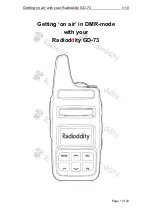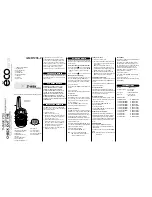
GTR 8000 Base Radio
1.3.2 Supported Frequencies for HPD
The GTR 8000 Base Radio is available for 25 kHz operation in 700 and 800 MHz frequency bands.
1.4 Overview For a GTR 8000 Base Radio in a Trunked
IP Simulcast Subsystem
The base radio captures inbound signals through external receive (Rx) antennas from the subscriber/mobile radios
and then amplifies, filters and demodulates the signals into voice packets which are forwarded to a comparator. The
comparator processes the received voice packets for a particular call and forwards the best quality voice packets to
the zone core, which routes them to the associated base radio at each remote site. At a predetermined time, all of the
base radios transmit the voice packets simultaneously on the same frequency to complete the communication.
A maximum of 30 base radios can be installed per remote site. Each base radio has an Ethernet connection to a
switch at the site for the Network Management interface.
1.5 Overview For a GTR 8000 Base Radio in a Trunked
Single-Site Repeater Configuration
This configuration consists of standalone GTR 8000 Base Radios and standalone GCP 8000 Site Controllers in
a single-site repeater configuration, or can be used in a multi-site system to provide a system migration step that
enables replacement of PSC 9600 Site Controllers or base radios other than the GTR 8000 Base Radios. The base
radios may be colocated with the site controllers, or be separated (non-colocated) from the site controllers.
This configuration can only be used in non-voting configurations.
Support is provided only for FDMA when the base radios are physically separated from and not colocated with the
site controllers. TDMA requires the use of a frequency reference and timing reference that can only be provided
through the site controller’s CP3 links, which cannot be extended to non-colocated base radios when the distance
exceeds the noted limits. This configuration is supported only on repeater sites.
An Ethernet cable is used to extend the site controllers signal to the first non-colocated base radio through the site
controllers Net AUX port into the base radios SC-A port. The site controllers Net AUX port must be enabled and
configured using the CSS for 100/FULL (speed and duplex). When the distance between the site controllers and the
first non-colocated base radio exceeds 328 ft. (100 m), an external HP 2610 or HP 2620 24-port Ethernet LAN
switch must be used to extend the site controllers signal. When there are additional non-colocated base radios and
those base radios are more than 328 ft. (100 m) from the previous non-colocated base radio, additional Ethernet
LAN switches are required to continue to extend the site controller’s signal. See
1-4
6871022P86-A - November 2012
Summary of Contents for GTR 8000
Page 2: ......
Page 4: ......
Page 6: ......
Page 14: ......
Page 18: ......
Page 22: ......
Page 26: ......
Page 60: ......
Page 177: ...5 8 1 3 VHF Tuning Procedure Figure 5 1 Preselector Tuning VHF 6871022P86 A November 2012 5 7 ...
Page 181: ...5 8 2 3 UHF Tuning Procedure Figure 5 2 Preselect Tuning UHF 6871022P86 A November 2012 5 11 ...
Page 230: ......
Page 234: ......
Page 244: ......
Page 286: ......
Page 300: ......
Page 338: ......
















































